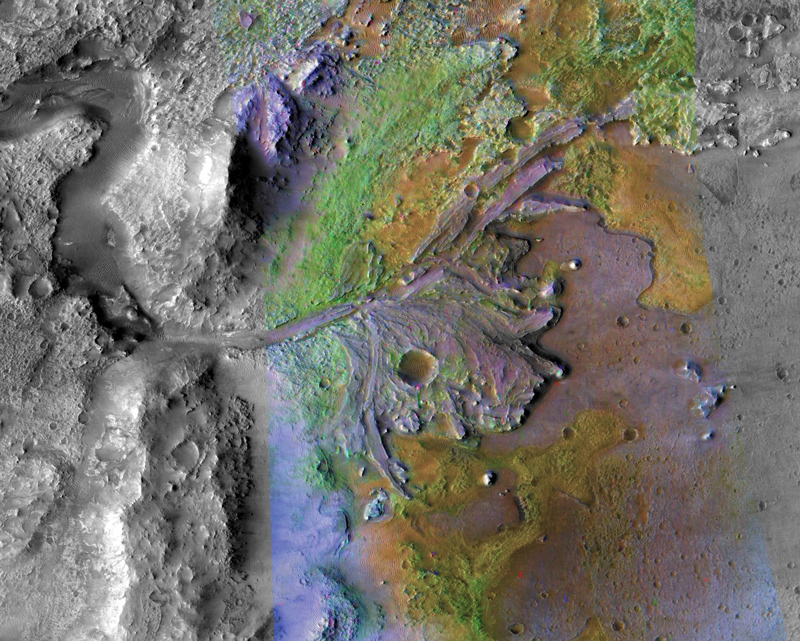Asteroid Impacts Could Have Warmed Ancient Mars
Posted on Categories Discover Magazine

Mars is a frigid world today, and all of its surface water is frozen solid. However, there’s ample evidence that liquid water once coursed over the Red Planet. That paradox has sparked an ongoing debate: What warmed up Mars’s climate billions of years ago? A team now has proposed that giant asteroid impacts—the kinds that carve out basins exceeding 1,200 kilometers in diameter—might have played an important role. The team reported its results in March in Geophysical Research Letters.
The gullies, streambeds, channels, and lake beds that pepper the Martian landscape are dead ringers, morphologically speaking, for water-sculpted terrain on Earth. The presence of hydrated minerals such as phyllosilicates and sulfates, which have been spotted spectroscopically by Mars-orbiting satellites, has provided more evidence that the Red Planet was once warmer and wetter. By dating geological features and water-altered minerals, scientists have determined that Mars must have been relatively balmy roughly 4 billion years ago.
Don’t Look at the Sun
The ancient warm spells that Mars appears to have experienced can’t be pinned on a seemingly obvious culprit such as the Sun. That’s because our nearest star wasn’t any more luminous in the past. In fact, the Sun’s power output several billion years ago was probably about 30% lower than it is today, said Lu Pan, a planetary scientist at the University of Science and Technology of China in Hefei. “The Sun was much fainter.” That fact has been troubling the scientific community for decades, Pan said. “Climate modelers have been trying to figure out ways to warm up the planet.”
Pan and her colleagues recently proposed one possibility, and it hinges on truly catastrophic events. Building on previous research, the team suggested that giant asteroid impacts—far larger than the one that killed off nonavian dinosaurs 66 million years ago—triggered chemical reactions in Mars’s crust and mantle.
In a process known as oxidation, iron-bearing minerals reacted with water present in Mars’s subsurface to produce iron oxides and hydrogen gas. That hydrogen then went on to collide with the carbon dioxide already present in Mars’s atmosphere.
All of that bumping together of molecules changes their electronic structure and allows them to absorb radiation at a wider range of wavelengths, an experimentally verified phenomenon known as collision-induced absorption. “These molecules become even better greenhouse gases,” said Ramses Ramirez, a planetary scientist at the University of Central Florida in Orlando not involved in the research.
Recent research has suggested that an atmosphere composed of both carbon dioxide and hydrogen can reach temperatures above freezing. On the other hand, a carbon dioxide–dominated atmosphere void of hydrogen or other greenhouse gases can attain a top temperature of only about −40°C, Ramirez said. “That’s over 40° too cold.”
Go Big or Go Home
Asteroids larger than 100 kilometers (60 miles) in diameter—more than 10 times the size of the dinosaur-killing impactor—excavate enormous basins when they strike a rocky body. Several such depressions persist today on Mars, including Hellas, Isidis, and Argyre. The impacts that formed those basins would have released copious amounts of hydrogen gas, Pan and her colleagues concluded, because both the asteroid itself and portions of Mars’s crust and mantle would have been oxidized.
The researchers calculated that impacts that produced basins larger than about 1,200 kilometers (750 miles) in diameter would have created enough hydrogen to heat Mars’s atmosphere to above freezing.
But those relatively balmy conditions wouldn’t have persisted indefinitely. That’s because hydrogen, being so light, tends not to stick around. “Even if you put a lot of hydrogen into the atmosphere instantaneously, it will escape very fast,” Pan said.
The Hellas impact basin—the dark blue circular region in this false-color image from the Mars Orbiter Laser Altimeter (MOLA)—is one of the largest known impact craters in the solar system, with a diameter of roughly 2,300 kilometers (1,400 miles). Credit: MOLA Science Team
On the basis of assumptions about the physical structure of Mars’s atmosphere, the researchers determined that on the order of a trillion molecules of hydrogen per second would have streamed out of every square centimeter of Mars’s atmosphere. Taking that exodus into account, Pan and her colleagues calculated that temperatures on ancient Mars would have remained above freezing for anywhere from about 20,000 to 1,000,000 years after the largest basin-forming impacts.
Twenty basin-forming impacts occurred early on in Mars’s history, according to previous research, and Pan and her team determined that 14 of those events could have boosted temperatures to above freezing.
Those results make sense, said Robin Wordsworth, a planetary scientist at Harvard University who was not involved in the research. But it’s important to consider the relative timing of asteroid strikes and the emplacement of Mars’s water-sculpted terrain, he said. If one is a cause and one is an effect, the two should sync up in time. But that’s not always the case, Wordsworth said, because the largest impacts predate features shaped by flowing water. “The big ones happen before we see valley networks,” he said. “That’s one of the big challenges of the impact-driven hypothesis.”
Pan and her colleagues acknowledged that discrepancy and suggested that Mars’s fluvial features, in some cases, might be older than they appear. It’s possible that erosion or other geological activity could have removed earlier signatures of water-carved features, Pan said. “We just don’t have an exact timing of those early processes.”